VOL. XVII NUMBER 1 ASSOCIATION NEWSLETTER MAY 2011
A veteran – whether active duty, retired, national guard or reserve – is someone who, at one point in his life, wrote a blank check made payable to “The United States of America,” for an amount of “up to and including my life.”
ODDS and ENDS
A question has been raised by a member wanting to know if any of our pilots remember being “captured” at Ft. Rucker during “escape and evasion” training and being subjected to waterboarding? This was described as being tied to a see-saw type board and being dipped down into a bucket of water.
At the 1988 VHPA Reunion in Ft. Worth, a pilot from our unit met Chuck Carlock and told him he had a copy of the “wanted poster” for any Firebird aircraft. It was in Vietnamese with a crude helicopter drawing. The pilot was from an era after Chuck’s tour (67-68). Does anyone out there have this and if so, can the Association get a copy of it?
On 27 November 1964, when our unit shipped out for Vietnam, Captain Cliff Ohlenburger started keeping a daily diary. This continued until 2 April 1965. These notes have been transcribed by Cliff and are being posted on our website. If you have remembrances of some mission that occurred during that time period, please email it to our webmaster, Gary White, and he will insert it at that date. Gary’s address is: gary@apptools.com .
On February 27th, our only living American survivor of World War I died. Frank Buckles was 110 years old. It was during the 1950s that the last survivor of the American Civil War died. Based on these timelines one would expect the last World War II veteran to expire around 2038 and the last Vietnam veteran to last until around 2068.
30 March 2011 was our official “Welcome Home Vietnam Veterans Day” as deemed by our lawmakers. Better late than never.
Steve Israel (WO 69-70) has written an eye-opening article for this newsletter comparing our Vietnam Army to the Army of today. I didn’t see anything about burning human bodily waste. Steve probably never did that though. I can still smell it in my mind.
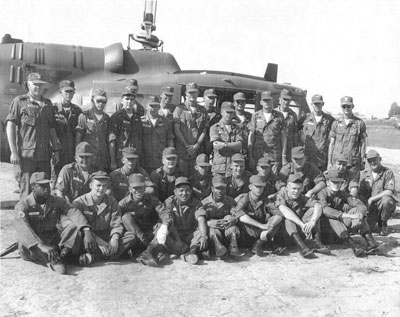
STANDING: CPT. Marvin “Duke” Schwem, WO Ken Linville, WO John Sullivan, WO James Prenderville, WO Alfred Brown (hidden), WO Roy Lowery, WO Ben Graves, WO John Clapp, 1LT. Joe Schenke, WO Mick Mason, CW# Shelton Foles, WO Jerry Rhine, WO Harold Christensen, WO Major Weber, CPT. Larry Osborn
KNEELING: SP/5 Earl Peck, SP/4 Gerald Kislek, PFC Elwood, SP/5 Donald Baker, PFC Jones, SP/4 Ted Stewart, ? , SP/4 Jacque Morigeau, SSGT Bernard Jackson.
SITTING: SFC Davis, PFC Nelson, SP/4 James Couty, SP/5 Swartz, Murry Vernon, PFC Gray, possibly Richards or Long, SP/4 Billy Johnstone
Roy Lowery (WO 64-65) sent the Association a photo taken of the 1st Platoon on 26 December 1964. We have identified all but a couple of the men in the photo. The photo is in this newsletter. If you can ID the unnamed men, please let us know who they are. To see a better copy of the photo, look at our online newsletter. If by any chance you have a copy of the 2nd and 3rd Platoons from this same time, please send a copy to the Association.
This newsletter has been mailed early to enable everyone to get the word about the Valorous Unit Award to be given at Ft. Rucker in May (see article below). For this one time only, our Address Directory will be mailed early also. It will be mailed by June 17th. In order to receive it, you must be a dues paying member. Check the address label on this newsletter. If there is nothing to the right of your name, you have not paid your dues. In order to receive the directory there must be a 2012 or Life on the label. Please send your dues to the Association where we receive it no later than June 10th. Dues are $12 per year. Life member dues are $125 if age 61 to 65 and $100 for 66 and over. Make your check to: 71st AHC Association and send to the address on the back of this newsletter. We do not charge for past due dues.
Our 2012 Reunion will be held at the Hilton New Orleans Airport Hotel from June 20th to June 24th. No reservations can be made until July though. This hotel is right across the street from the airport and about 13 miles from downtown New Orleans. Military Reunion Planners will be assisting us again.
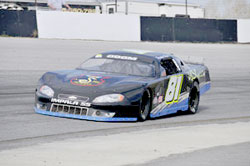
The race car photo in this newsletter was the result of Paul Teelin (WO 66-67) deciding to sponsor this car in a local race at South Alabama Speedway. The race was called the “Rattler Pro Late Model 100”. Our driver, Brandon Odom finished 10th out of 30 entries.
Paul sent us a copy of the racing magazine, “Late Model Digest” dated March 16, 2011. On page 38 they ran a full page photo of the hood of Brandon’s car showing the Rattler decal covering the hood.
Ray Casey’s company, Military Reunion Planners, has really gone big time. Ray is doing the VHPA (Vietnam Helicopter Pilot’s Association) Reunion now. That is probably the largest Vietnam era reunion held every year with thousands attending
VALOROUS UNIT AWARD
Through over five years of dealing with the bureaucracy, Doug Womack has accomplished getting the Department of the Army to approve a Valorous Unit Award for the 14th Aviation Battalion’s efforts in Operation Lom Son 719 in early 1971. All of the other aviation units had received this award in a timely manner.
This award is to be presented to what is now the 1-14th Aviation Battalion at a ceremony at the Aviation Museum at Ft. Rucker, AL in front of the Vietnam display at 1100-1230 hours on 20 May 2011.
A contingent from our Association and others from the 14th Aviation Battalion plan to attend the proceedings.
A block of rooms has been set aside for anyone who cares to attend. The rooms are at the Econo Lodge, 444 North Daleville Ave. Daleville, AL under the name Rattler-Firebird Group. The room rate is $57.68 per night TOTAL. Call 334-598-6304 for reservations. If the room block is full, please call Ron Seabolt at 972-524-9033 so the block can be expanded.
There is a lounge next door where I’m sure many of this group can be located on the evenings of 19 and 20 May.
GEORGE ANDREWS HOWES
Remains have been identified as being from “Andy” Howes, who was the co-pilot of the Firebird aircraft that went missing on 10 January 1970. Previously the remains of the other three crewmembers, Captain Herb Crosby, Francis George Graziosi and Wayne Clouse Allen had been identified and buried.
Services for Howes are planned for 5 August 2011 at 11am at Arlington National Cemetery. As this time nears and more information is learned, it will be posted on our website.
CAPTAIN HERB CROSBY
The following was received from MaryLou Wade regarding additional remains of her brother, Captain Herb Crosby, that were interred at Arlington National Cemetery on April 8th.
The service at Arlington was very beautiful, yet small of course. It was raining but that certainly didn’t put a damper on the honor and respect displayed by The Old Guard. The wooden urn which had an Army bronze medal on it with a gold name plate engraved with his information was beautiful. It was placed on a small green cloth covered stand. I placed the flowers at his headstone. And, the little laminated card that I placed there in December with his photo and Rattler Firebird information/logos, etc. was still there!!!! I couldn’t believe it, but there it was when we walked up to the grave. The service was short, yet very nice indeed. No dry eyes.
During the service I turned to Dan and caught the vision of someone sitting behind us. I looked back, saw this face and knew the face, looked down to his name on his retired flight jacket to confirm, and yes, it was Doug Womack. He arrived shortly after we had set down (they started a little earlier than 1400 since we were all there and ready). I was so happy and surprised to see Doug. It’s an hour and 20 minute drive for him to come. Afterward we talked for a long while in the Arlington Administration office. So good to see him again and talk with him. I’m so happy a Rattler/Firebird was there. Doug was in Vietnam just after the loss of firebird 91 and crew. He helped search for him. I know Doug well from the reunions.
It was more than I ever thought it would be. Our Army family is the best in the world. Absolutely.
TAPS
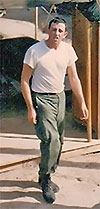
Vinnie Harrington
The Association has learned of the following deaths since our last newsletter:
- Donald L. Baker (EM 64-65) was evidently DEROS swapped into A/82nd AVN of the 173rd Airborne Brigade and died with an entire crew in an aircraft crash while flying IFR on 12 June 1965 at night. Info received from Gerald E. Kislek. Baker is seen in the Roy Lowery photo in this newsletter.
- Bob Burroughs (OF 67-68) died 24 December 2010 of cirrhosis of the liver.
- Robert L. Cushman (WO 67-68) died 21 November 2005 of unknown causes.
- William T. “Willie” Hargrove, Sr. (WO 65) died 11 March 2011 of unknown causes.
- Vinnie Harrington (EM 65-66) died on 28 March 2011 of cancer.
- David (Duck) Winters (EM 67-68) died 30 December 2010 of cancer.
TAPS TRIBUTES
Jim Gibbs passed on this information about Bob Cushman. His dad was the former Commandant of the Marine Corp General Robert E. Cushman, Jr. He had previously commanded all Marine forces in Vietnam from June to December 1967.
Ron Seabolt – I will forever miss the happy smile of Vinnie Harrington. Vinnie and Micky never missed a reunion and they were a pleasure to be around.
MaryLou Wade – Sure hit Dan and I hard as Vinnie just touched our hearts dearly the first time we met him in Denver at the Rattler Firebird reunion. We’d wink at each other, and finally connected. Since then it’s always a wink and a hug. He told me many stories of Vietnam and how he should have died in November 1966, (note: his crew chief, Leslie Don Moses, was killed on the mission) but it wasn’t his time. I loved hearing his stories, and he was still telling me them the last I talked with him which was a week ago Friday.
He knew what was coming. He told me at the Nashville reunion he probably wouldn’t make the next reunion and all about his cancer but he was going to fight it the best he could without having to go through chemo to extend his life a few months. He took quality over quantity and left it to God to determine when. He’ll be missed, indeed.
Gary Parks (EM 65-66) knew Vinnie well and made the trip to the Boston area from his home in Tennessee to represent our Association.
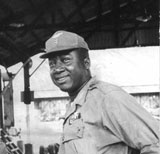
CW3 Willie Hargrove – 1965
John Mateyko – Two things about Willie Hargrove I remember: I wasn’t in RVN five days and for some reason or another I was in the maintenance area. Willie came over, told me to hop in a D model and follow him to Vung Tau as one of our B models had to go into 4th echelon maintenance. I walked over to the Snake Pit, and returned with a D model. He started the B model, sloppily got it into the air and off we went. He did a decent approach but a sloppy touchdown. After giving the helicopter to our friends at Vung Tau he climbed into the left seat of the D model and we headed back to the Snake Pit.
On the flight back, he told me that there were no hydraulics in the B model. Heck, I had a tough time flying with the hydraulics off, I have no idea how he got it off the ground and then landed from a hover.
The other thing I remember is that he was one heck of a poker player.
“Duck” Winters received his nickname from when he first started flying as a door gunner. He was told they were going on a mission to a “free fire zone”. Duck supposedly asked what that meant and was told that you could shoot anything moving that you see…..and he did, shooting up a flock of ducks. R.I.P. Brother.
David Winters was cremated and is to be buried in August according to his sister Norma Priss. She can be reached at 3055 Belcastro St., Las Vegas, NV 89117. Phone 702-460-6670.
EDITORIAL by Ron Seabolt
I entered the U.S. Army on March 16, 1966, over 45 years ago. Get it over with was the only thing on my mind. Little did I dream what an impact the next two years would have on my life. I was just like every US (draftee prefix to my serial number) I met with typical comments like FTA (f— the army), and all I want to be is a PFC (private f—— civilian). I was proud to do my service but could not wait to get on with the rest of my life. Re-upping was as far as it could be from my mindset. At the time, March 15, 1968 was one of the greatest days of my life. My obligation was complete and I was through playing soldier. I never was too good at it anyway.
Forty-five years later, with (too) much maturity behind me, I realize just what the Army did for me in just two years. It gave me the greatest friends one could ever hope to have. I knew these guys I served with were friends but the scope of friendship has so far surpassed that point with our Association that it is unbelievable. With age, I now look proudly at my Vietnam tour as one of the defining moments of my life and I wish to thank you who are reading this for giving me the privilege of serving you.
YOU CAN LEAVE THE MILITARY, BUT IT NEVER REALLY LEAVES YOU
BY KEN BURGER, THE CHARLESTOWN POST AND COURIER
Submitted by Robert A Pavlik (EM 64-66)
The military, for all its flaws, is a comfort zone for anyone who has ever worn the uniform. It’s a place where you know the rules and know they are enforced; a place where everybody is busy but not too busy to take care of business. Because there exists behind the gates of every military facility an institutional understanding of respect, order, uniformity, accountability and dedication that becomes part of your marrow and never, ever leaves you.
Personally, I miss the fact that you always knew where you stood in the military, and who you were dealing with. That’s because you could read somebody’s uniform from 20 feet away and know the score. Service personnel wear their careers on their sleeves, so to speak. When you approach each other, you can read their name tag, examine their rank and, if they are in dress uniform, read their ribbons and know where they’ve served.
I miss all those little things you take for granted when you’re in the ranks, like breaking starch on a set of fatigues fresh from the laundry and standing in a perfectly straight line that looks like a mirror as it stretches to the endless horizon. I miss the sight of troops marching in the early morning mist, the sound of boot heels thumping in unison on the sidewalks, the bark of sergeants and the sing-song answers from the squads as they pass by in review.
To romanticize military service is to be far removed from its reality, because it’s very serious business, especially in times of war. But I miss the salutes I’d throw at officers and the crisp returns as we crisscrossed on the flight line. I miss the smell of jet fuel hanging heavily on the night air. I even miss the hurry-up-and-wait mentality that enlisted men gripe about constantly, a masterful invention that bonded people more than they’ll ever know or admit.
I miss people taking off their hats when they enter a building, speaking directly and clearly to others and never showing disrespect for rank, race, religion or gender. Mostly I miss being a small cog in a machine so complex it constantly circumnavigates the Earth and so simple it feeds everyone on time, three times a day, on the ground, in the air or at sea. Mostly, I don’t know anyone who has served who regrets it, and doesn’t feel a sense of pride when they pass through those gates and re-enter the world they left behind with their youth.
Face it guys, we all miss it to some degree. Whether you had one tour or a career, it shaped your life.
560 FLIES AGAIN
By John Mateyko – Rattler 2-1 (OF 65-66)
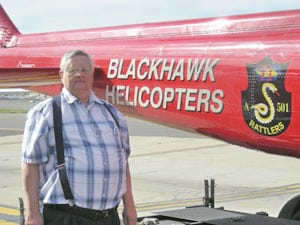
John Mateyko and 560 (N214KK)
US Army UH-1D 64-13560 was assigned to Co. A, 501st Aviation Battalion (Rattlers/Firebirds) at Bien Hoa in 1966. Rattlers provided helicopter lift capability to the US 1st Infantry Division, 25th Infantry Division, 173rd Airborne Brigade, Special Forces and Advisors; the Vietnamese 5th, 10th and 25th Divisions; the 1st Royal Australian Regiment; the 161st Battery, Royal New Zealand Artillery; the Republic of Korea Marines; and armed helicopter support for US Marine Corps units operating in the northern provinces. Rattler and Firebird pilots provided In Country Orientation to pilots of the US Navy armed helicopters and pilots of the 9th Squadron, Royal Australian Air Force when those units initially deployed to Vietnam; and tactics orientation to USMC pilots when The Corps Huey gunships arrived in Vietnam.
A/501st was awarded the Presidential Unit Citation and the Vietnamese Gallantry Cross. Members also received a letter from the USAF Military Airlift Command in recognition of Search and Rescue missions flown by the Rattlers/Firebirds.
I was one of the company pilots who flew 560 on a rotating basis; slick drivers generally did not have an assigned aircraft. On any given day, any slick pilot and any D model could be doing Ash and Trash, med-evacs, combat resupply, combat assaults and extractions or USO transport missions. It was not unusual to give rides to Vietnamese civilians and military personnel going from village to village. If at H-3(Saigon’s general use heliport), we’d take FNGs to their advisor village or SF camp.
I was one of the few military pilots who kept a civilian flight log book in Vietnam. After each day of flying, I would record not only the flight time and landings as logged in the military flight records, but also tail number. Comments regarding the company cross country on 24 March 66 from Bien Hoa to Ban Me Thuet via Phan Thiet and Nha Trang in 560 and the direct return to Bien Hoa on the 28th are recorded. We went to II Corps to support the 155th Helicopter Company (Stagecoach) for five days. On 24 February we supported the 161st Battery of the Royal NZ Artillery; an Air Force CH-3 carried the howitzers externally from a fire base west of Duc Hoa to Bien Hoa while I used 560 to carry external loads of canvas, support equipment and ammunition to Bien Hoa.
The Rattler-Firebird Association meets each even numbered year and can be found on the Internet. Using the Internet, Ken Krauss of Blackhawk Helicopters traced the history of registration number N214KK which is in their fleet domiciled at El Cajon, California. He got as far back as A/501 and asked our National Director Ron Seabolt what type missions 560 would have flown during its service in our combat zone. Ron put out a request for any such information to be forwarded to Blackhawk. I sent extracts showing flight information on twenty different days. During the exchange of messages, Ken mentioned that if I were ever in the San Diego area to please stop in. I expressed an interest and Ken added, “When you’re here to look at her, be prepared to fly…..”
The first time I flew 64-13560 was on January 24, 1966. I was in 214KK forty-five years and two days later on January 26, 2011. In reality I was representing the slick pilots who weren’t there as well as all military pilots who will never have the opportunity to fly the aircraft they flew in combat. I was humbled doing so. In the practice area (same-same tactical stage field) I was really humbled. I tried to hover it and just couldn’t. After several tries, I gave up and Ken took the controls. Our primary mission was to get some footage for a documentary film for the photography ship – a Robinson R-22. We ran northbound and southbound between some hills, just like nap-of-the-earth flying at 100 feet. We then flew to the highest point in San Diego Country, about 6,000’. At the end of the day I was happy to have flown the ship I flew in combat many years ago and knew I was blessed when I realized all the things that had to fall into place to make this event happen. Truly a once in a lifetime experience.
Dedicated to the members of aircrews who didn’t come home.
RANK STRUCTURE, i.e. EM versus WO versus OF
This column on Rank Structure is being written for the benefit of those reading this that never served in the military or is not married to a retiree. In other words, my wife thought all pilots were warrant officers and it dawned on me that many wives might think the same thing. So why not try and explain it to the uninformed readers?
EM or enlisted men are the lowest rank and file of the services. During the Vietnam War a person joining the Army would have normally entered the service as a private E-1. E-2 would have been obtained at some point upon graduating from Basic Training or during AIT (Advanced Individual Training) if the person kept his nose clean. Everyone who was not an E-3 (Private First Class) was given that rank upon arriving in Vietnam.
The rank of E-4, for most Army personnel, would have been awarded several months later once the serviceman proved he could do his job and stay out of trouble. This would have come in the rank of Specialist 4th Class, or commonly called “Spec 4”. Another E-4 rank that was available was the lowest Non-Commissioned Officer (NCO) rank of Corporal. A Spec 4 and a Corporal are both the same pay grade of E-4 but the Corporal rank is a “command” rank, meaning the Corporal would be in charge of the Spec 4s. Another term for a Corporal is “Hard Stripe E-4”
This same structure applies to a Specialist 5th Class, or Spec 5 versus a Sergeant E-5, also known as a “Buck Sergeant”. Both are E-5s.
In Vietnam there were some Specialist 6th Class (E-6) and a few Specialist 7th Class (E-7) to be found. The “hard stripe” version would be Staff Sergeant and Sergeant First Class.
The highest ranking enlisted person in a company sized unit was an E-8 First Sergeant. You might however have an E-8 Master Sergeant now and then, but the First Sergeant was the top dog. He may be known as Top or First Shirt but by whatever he was known, you never wanted to be on the bad side of your First Sergeant if at all possible.
At the Battalion level and above the top enlisted person would be either a Sergeant Major or a Command Sergeant Major, both of whom are E-9s, the top enlisted pay grade.
Warrant Officers outranked all enlisted men. This rank had officer privileges, was saluted by enlisted men, but would not normally be in a command position outside of their specialty. Almost all Warrants in our unit had the specialty of being helicopter pilots. Upon graduation from flight school they pinned on the WO-1 bar on their collars. About a year later, if they kept their nose clean, they became a CWO-2, or Chief Warrant Officer. In the Vietnam era CW-4 was as high as you could obtain in the Warrant Officer Corp. Years later the rank of CWO-5 was established.
Officers or RLOs (real live officers) as they were often referred to, began at the rank of Second Lieutenant (O-1). In the Vietnam era they would have been assigned to a particular branch, such as Infantry, Artillery, Engineers, or Transportation and then may have gone to flight school to become helicopter pilots. Nowadays the Army has a separate Aviation Branch.
The second lieutenant could have received his commission in several ways. He could have been in ROTC in college and received his commission upon graduating. He could have gone to Officer Candidate School (OCS) upon graduating from basic training. He may have attended West Point and was commissioned upon graduating. He could also receive a “battlefield commission” if deemed worthy by “higher, higher”. However he got his commission, by the time he went through flight school and got to Vietnam, he was almost always a First Lieutenant (O-2).
In the early stages of the Vietnam War, there seemed to be more high ranking officers in the chain of command in the Rattlers and Firebirds. For instance in late 1966, all platoon leaders were Majors (O-4), as was the Commanding Officer, the Executive Officer (second in command), and the Operations Officer. Captains (O-3s) were also very common in the company at that time. By the end of our units’ time in Vietnam, September 1971, we were commanded by a Captain instead of a very senior Major.
LOVE LANGUAGES
By Kay Seabolt
Many of you know I attend a support group at the VA for spouses of veterans with PTSD. I’ve heard all sorts of stories about how PTSD has affected the lives of not only our veterans, but also those who love them. Most of the women in our group are in their marriage for the long haul, but some are on the brink of a break up.
One of the subjects we discussed a few months ago was “lack of intimacy.” This seems to be a common problem with PTSD suffers. The counselor suggested that we read The Five Love Languages by Gary Chapman. This is an excellent book whether your marriage is rock solid or whether it could use a little work. The premise of the book is that there are five love languages, and if each spouse knows each other’s love language you will know how to express love for your spouse in a way that suits him or her, and ultimately make your marriage stronger. Since I’ve been recruited to write an article for the newsletter, I thought this book might be a good topic.
There is a test in the book for both spouses to take that tells you what your love languages are. For instance, mine are Quality Time and Acts of Service. Ron’s are Words of Affirmation and Quality Time. And yes, I did get him to take the test.
The five love languages are:
- Words of Affirmation
- Quality Time
- Receiving Gifts
- Acts of Service
- Physical Touch
What’s really important for you guys to know is what these love languages are NOT. (I write some of these from personal experience.)
Words of Affirmation is not saying, “I’ve sat right here and ate a hell of a lot worse.”
Quality Time is not asking if I want to go run the hog trap or watch you clean your guns.
Receiving Gifts is not giving a tool or flashlight for Christmas.
Acts of Service is not expecting kudos for taking out the trash when it’s your job anyway.
Physical Touch is not asking for a free feel!
I don’t know about the rest of you, but Acts of Service for me is when Mr. Ron makes up the bed and runs the vacuum to save my worn out back, and cleans up in the kitchen after I cook dinner. That says LOVE to me. As for Quality Time, there’s the time last month when he drove me around out in the country for about 2 hours to see the bluebonnets in bloom and stopped along the way to let me take pictures. What a guy!! I realize it was not his cup of tea, but I sure appreciated it. I may have to go with him to run that hog trap after all.
Take care and hope to see you in New Orleans next year.
ARMY RETIRES LEGEND
January 27, 2011
Knight Ridder/Tribune
YAKIMA, Wash. — An icon of the Vietnam War, a faithful conveyer of American troops across the globe and savior to countless lost or injured civilians, the Huey helicopter’s long Army service is ending.
For the medevac detachment at the Army’s Yakima Training Center, that distinguished career concluded Wednesday.
More than 50 years after the first models lifted off, the Army is retiring the few single-bladed UH-1 variants still sitting on the flightline.
Wednesday’s retirement ceremony at the training center was a bittersweet moment for the pilots, crewmen and passengers who came to know the Huey as a reliable machine for both combat missions and stateside duties, most notably civilian search and rescue.
Chief Warrant Officer Joseph Long, part of the Training Center’s Air Ambulance Detachment, is probably one of the last Vietnam-era Huey pilots serving today. He was recalled to active duty in 2002 because the Army didn’t have enough Huey-trained pilots.
Long had the honor of piloting the last formal Huey mission at the training center as part of the flyaway retirement ceremony on the parade ground. Sitting on his left was retired Lt. Col. Bruce Crandall, who received the Medal of Honor for flying 70 wounded troops out of Vietnam’s Ia Drang Valley in 1965.
Long said newer helicopters have been threatening to push the Huey out of service for 30 years.
“It just never happened,” Long said. “It was always pulling a mission.”
The Huey is considered the most widely known modern helicopter, thanks to numerous Hollywood depictions and the characteristic “whoop-whoop-whoop” sound made by the spinning main rotor.
“It’s an iconic aircraft. It’s an amazing thing to be able to fly something that everybody knows,” said Maj. George Johnson, commanding officer of the training center’s medevac detachment.
The Huey was well known in its role as a medevac chopper and its pilots earned a reputation as the “cowboys of aviation” for their willingness to fly whenever, wherever, however if somebody needed help under fire. The bird was nicknamed “Dustoff” for the cloud of dirt kicked up on takeoff, a name still given to medevac crews. But the Huey also served as a troop transport and air assault platform, part of the military’s decision to broaden the Army’s aviation aspect for the “helicopter war” in Vietnam.
Seven thousand flew in Vietnam; more than 16,000 were made. The Huey differed from its predecessors by use of a turbo-shaft engine that took up less space.
“There’s no doubt that without this aircraft, we couldn’t have done what we did there in Vietnam,” said retired Col. Phillip Courts, commander of the Army’s Ninth Aviation Brigade in Vietnam and a guest speaker at Wednesday’s ceremony.
Courts told how he once led a group of 35 Hueys from Fort Lewis to Portland before heading east along the Columbia River on their way to the training center. Hoping to find a path through bad weather, he punched ahead of the rest of the choppers but ended up having to land. The crew spent the night grounded and then flew toward Union Gap, where a shortage of fuel forced him to land short of his destination.
“I had to live with that for several years, but the story ended well,” Courts said.
Many who boarded the Huey could tell the same story. Even when the Huey crashed, it often held together well enough to spare the occupants from major injury.
Don Morris, a retired Army command sergeant major from Ellensburg, on Wednesday recalled surviving crashes in the jungle and a rice paddy.
“They could take the abuse and keep on going,” Morris said.
Other helicopters carry more technology and are better outfitted for today’s military. But fans of the original Huey know that their favorite helicopter could stay in the air for another 20 years. The seven Hueys in the training center fleet will be turned over to the Air Force to serve as training aircraft.
At least two will remain in service at Fort Rucker, Ala., the epicenter of the Army’s aviation program, an Army spokeswoman said.
Even though Wednesday’s retirement flight was limited by fog, Crandall said he still enjoyed the chance to go up one more time in an active-duty Huey.”That’s the best helicopter ever built up to now,” he said.
FORTY YEARS IN THE FUTURE – A CONVERSATION IN TIME
By Steve Israel (WO 69-70)
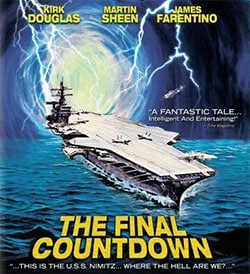
One of my favorite movies is a quasi-science fiction flick: The Final Countdown. Released in 1980, the movie’s story line is thus. The USS Nimitz, a modern day nuclear-powered aircraft carrier, while on maneuvers in the Pacific, somehow goes through a time warp to end up back in the Pacific on December 6, 1941. The movie does an admirable and sometimes amusing job of highlighting the differences in how we fight a war 40 years later. The Nimitz’ skipper, played by Kirk Douglas, is ultimately faced with the dilemma of whether to use the technology at his command to stop the attack on Pearl Harbor and thus change the course of history.
I thought it would be an interesting study to examine some of those same changes in how we fight a war today, versus forth years ago in Vietnam. The vehicle in which we will conduct this comparison is in the form of a short scene from a play. Assume for a moment that somehow an aviator assigned to the 71st AHC (Rattlers) in 1969 has magically been hurtled through time to find himself in Iraq, 2011.
Scene One
(As our scene opens, Joe , our Vietnam-era Rattler is beginning to accept his unbelievable situation. He is sitting in a lawn chair, outside a “hooch” at an American airbase in Iraq, in 2011. Harold and Robert, two present-day Army aviators are attempting to address Joe’s numerous questions. Bringing Joe up to date on forty years of technology and history is proving to be no easy task. Its late afternoon and the our characters are passing the time before supper is served at the mess hall)
Joe: So on a hot day with a high density altitude and a full load of fuel, how many troops can you put in the back of this Blackhawk?
Robert: (acting as if this was a stupid question from an aviator) As many as we can fit!
Harold: Give him a break Robert! Remember he flew Hueys. I got a few hours in one of those antiques in my Guard unit. Pretty sad underpowered aircraft. And that was digital displays and glass cockpits.
Joe: Glass cockpit? Why would they replace plastic with glass? And please tell me this. As I look out into the distance all I see is sand – no terrain features for navigation. How do you manage to locate grunt units out in that desert?
Robert: We just plug their coordinates into the GPS.
Joe: GPS??
Robert: Yeah, it’s a navaid that will take you direct to any point on earth, and provide you with continuous distance and time-to-station data. In fact it will even show your position on a digital map. It uses satellites in space to triangulate its position.
Joe: (scratching his head in disbelief) Wow! Theoretically, that technology could be used in targeting.
Harold: It’s not theory. Its reality – and we also use laser targeting very pretty effectively.
Joe: Laser targeting?
Robert: Well, you see a laser is a……… (interrupted by Harold)
Harold: (gazing at his digital watch) Hey, what time is it? We need to get to the mess hall early tonight. Its lobster night, you know?
Joe: (glaring at Bill with a highly skeptical look) Lobster….in an Army mess Hall, huh?
Harold: Oh yeah, the contractors do a pretty good job with chow. My favorite is Tuesday night. They serve specialty dishes from one of the chef’s native countries. Last Tuesday we had some excellent curry.
Joe: (growing skepticism) Right! Got it! Let’s move on to another subject. So how long does it take to get mail from home?
Robert: Depends on how big the attachments are, but usually within minutes.
Joe: (getting slightly annoyed at the prospect of being the subject of a joke) What the hell are you talking about?
Robert: Oh that’s right. You guys had no internet in the sixties. Now we communicate by computer, with anyone, anytime and anywhere on earth, virtually in real time. My wife took photos of the kids at soccer practice this afternoon. You want to see those pictures?
Joe: Sure, sure…. and I guess you have an IBM or Univac in the shed out back of your hooch? And you’ve got photos from home; that you say were taken today? And I suppose you also have some magic mini-telephone in your pocket on which you can tell your wife how much you enjoyed the photos?
Robert: No. My “laptop” is in my locker. And I share the cell phone with three other guys. Cell service is pretty expensive from here, you know? So unless it’s an emergency we usually just do a live video conference.
Joe: Laptop? Cell phone? Video conference? What language are you speaking? The sun has obviously fried your brain…… (Joe is distracted by the sight of an attractive female in uniform) Hello sweet thing…. I guess the base hospital must be nearby.
Harold: Yes, why? You OK?
Joe: Yeah, fine…didn’t you mutts see that hot looking nurse?
Robert: You mean her? (pointing to the female). She’s our XO!
Joe: Now I know you guys are pulling my leg. A female aviator? In a combat zone? OK, I’ll bet you guys a bottle of scotch that there’s a medical corps insignia on her lapel.
Harold: And just where do you think you can get that bottle of scotch? There’s no alcohol allowed in country. And no club either! But you can buy me a latte. There’s a Starbucks on the way to the mess hall. (pausing to realize that Joe may not be familiar with Starbucks) It’s a coffee house and I’ll buy. I just need to stop by the ATM outside the Baskin Robbins near the main PX.
Joe: All right, I know Baskin Robbins, but ATM, what’s that?
Robert: (smirking as he knows the reaction his answer will undoubtedly evoke) It’s a money machine. You just put your credit or debit card into the machine, type in a few numbers and voila! Cash comes out like magic. You can also pay bills electronically or transfer money from one bank account to another.
Joe: So what can I do with these? (pulling a wad of military payment certificates from his wallet)
Harold: Nothing.
Joe: I hope you guys are having fun at my expense. (sigh) But I do have one question on which I really want a straight answer. How did Vietnam end? Did we ultimately destroy the Ho Chi Minh Trail? Did we kick the NVA’s ass? Did South Vietnam invade the North? Is Hanoi now a vacation spot?
Harold: (looking away trying to hide a shameful, apologetic look) We pulled out starting in ‘73’. In April of ‘75’ the country fell to the Communists.
Joe: (bewildered) Wow! I bet they’re still celebrating in the Soviet Union.
Robert: Nope! The Soviet Union as you knew it collapsed under its own weight. The cold war is over and the Berlin wall came down.
Joe: Was Nixon still President when the Soviet Union fell apart?
Robert: Nope! Nixon resigned under pressure. Ronald Reagan was President when the cold war ended.
Joe: Ronald Reagan, the actor?
Robert: That’s right.
Joe: OK, guys. I was born at night, but not last night. Let’s see – you expect me to believe that we just walked out of Vietnam; Nixon resigned the presidency; and the cold war ended without a shot being fired, while an actor was our president!
Harold: That’s right.
Joe: Sure, sure. And I suppose you’re gonna’ try to tell me we gave away the Panama Canal?
(Scene one closes with Robert and Harold just staring at each other, slowly shaking their heads)
Note: Consulting on this article was Maj. Kacie Brashear, a female U.S. Army Aviator and veteran of two tours in Iraq.
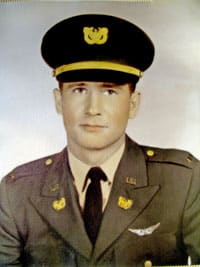 David Rolland Jackson
David Rolland Jackson KIA 25 Sept 1969
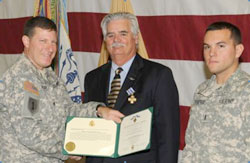 Frank Anton reeiving his DFC
Frank Anton reeiving his DFC
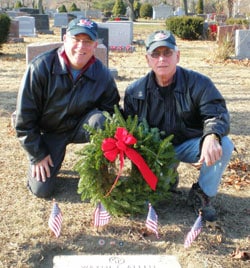 Vic Bandini and John Wiklanski at Wayne Allen’s grave 12 11 2010
Vic Bandini and John Wiklanski at Wayne Allen’s grave 12 11 2010
To be sure of hitting the target, shoot first and call whatever you hit the target!
